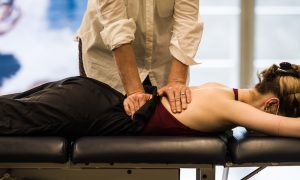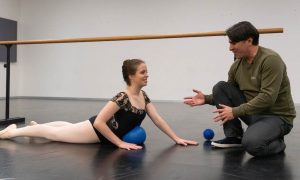As dancers, we despise the idea of being injured and having to take time off. But what does “time off” really mean? Is it possible to return to dance as strong, or even stronger, than we were before? And are there any positive sides to injuries?
This article was written by Rain Francis, in consultation with Lisa Howell of Perfect Form Physiotherapy.
As a dancer, what are some things I can do while I’m injured to stay in shape?
“There are so many things that you can do while injured to not only stay in shape, but also to perfect your technique and also to ensure that you prevent that injury from occurring again (if at all possible). It is very important to have a carefully planned and structured program that addresses all the things you would normally be training in class. For instance, if you can’t jump due to a foot injury, it is essential to keep training the strength of your whole leg, pelvis and core, rather than just rehabilitating the foot. In conjunction with your therapist, you should try to identify all the things that led to the injury developing in the first place, especially if it was a chronic injury that came on over time.
It’s also important (if at all possible) to have a cardio training component of your rehab program, for maintaining your level of cardiovascular fitness but also for maintaining the health of your mind. When you stop dancing, you may suffer from the lack of endorphins you normally get during exercise, which can lead to feeling sad or depressed. Besides giving you that natural ‘kick’ that keeps your spirits up, a personalized cardio program is a safe way to push you within your limitations for your injury.
If you can’t move a certain body part (such as an acute fracture in your foot), you can intensify the focus of your rehab program by improving other areas of your technique (such as your extensions). The aim for any dancer who is off dancing due to an injury is to actually return to dance better than you were before you got injured.”
After surgery on my ankle or knee, will I be able to get back to where I was, in terms of strength?
“This is a tricky one to answer, as it really depends on the injury, and the surgery. However, usually yes! In fact, with the right treatment you should be even better than you were before. A lot of people I treat end up being glad about the injury, because it gave them chance to retrain their technique and learn so much more about their body.
It’s very important to listen to your surgeon and your physio about the time it takes to come back, and what you need to do during that time. Don’t rush back to dancing – even if things feel fine, remember that there is internal healing going on that you can’t necessarily feel.”
Are there any positive sides to having time off?
“Yes! As I have said previously, often dancers come back even better, more aware and stronger. Time off allows you the chance to learn more about your body and to focus on aspects of your dancing that you don’t normally have the time to work on. Turnout often increases, too, because rather than gripping and overdoing it, with rest hips are able to relax and free up a lot more. Once you learn how to isolate your true turnout muscles in each position, you will feel much stronger, yet freer, in the hips.
Currently in dance training there is little periodization through the year. Ours is one of the only sports without an off-season, and we’re expected to perform at 150 percent all the time. Time off, or periodized training, allows the body some deep resting time, meaning proper recovery and the chance to come back with much more enthusiasm, strength and endurance.
Often, when we are not able to dance, it really reaffirms our love for it and how much we want to do it. Some people go the other way and question why they’re even doing it, but many come back with a renewed focus, determination and dedication for where they want to go. That’s one of the biggest psychological benefits of enforced rest – it makes us really look at why we dance, where we want to go and how willing we are to do the work to get there. Often when people come back after a challenge they are far more focused and progress much more quickly.”
I’m worried that I’m going to get behind if I take time off. How can I avoid this?
“A lot of dancers will avoid reporting an injury because they’re scared of having to take time off. But ‘resting’ doesn’t have to mean ‘doing nothing’. It’s all about relative rest. If there are structures that need rest in order to heal, it’s only those parts that need to rest. If you have a stress fracture in your foot, that’s only one bone in your foot, there’s 98 percent of the rest of your body that can still be trained. You’ll often notice far greater improvements in the rest of your body if you continue to train them safely. Injuries like stress fractures happen over time, so time off will allow you to fix the issues that contributed to the injury, which will accelerate your performance and development.
You should spend about 50 percent of the hours you would normally be training doing rehabilitation-style exercises. So, if you’re in full-time ballet, dancing 25-30 hours a week, you should be doing about 15 hours of rehab a week. That level of intense rehabilitation has to have a positive effect on your entire body. Combine this with cardio training, research into character development of your repertoire pieces, learning about anatomy, and exploring your own choreography. There are so many things you can dive into at this time that will make you a much better dancer.
Don’t be afraid to report an injury. Deal with the issues as they come, as it’s much easier to fix with the first symptoms than waiting until they get out of hand.”
Do I need a specific program to help me get my strength back?
“Yes, definitely. Every body is different and every injury is different. You need a specific program to make sure you’re getting the optimal benefits of your time off. It should also be structured to your dance style, level of training, type of injury, and what you want to get back to. Knowing exactly what you need to do (and not do) week by week will really help you keep focused.
Your program should include progressive developments of all of the movement patterns you use in your dance style, so that when you get back into class, those movements have been retrained from the ground up. Otherwise, it is more likely that your injury will reoccur.
Also make sure that you avoid over-stretching. A lot of people just stretch when they’re off, which is one of the worst things you can do because the muscles lose their strength, become very lax and don’t fire correctly.”
What are the most important things to keep in mind when returning to dance from an injury?
1. Get a correct diagnosis. Make sure it makes sense to you and feels right; otherwise, you can spend a lot of time trying to fixing something that isn’t relevant.
2. Find a great therapist.
3. Use relative rest, so you’re resting what needs to be rested, but not your whole body.
4. Correct all of the factors that led to the injury developing in the first place.
5. Refine your technique. Make sure anything that needed attention is getting worked on.
6. Ensure ultimate nutrition, to assist the cellular healing that’s happening inside your body. Make sure you’re getting all the right nutrients and enough hydration.
7. Progress at your own pace.
8. Get back into class, but a modified class, so you’re hearing the music, being around all your peers but not damaging anything that is healing.
9. Don’t go back too quickly. Be back in the class environment, but don’t rush it.
10. Use ‘time off’ as a time to learn and reconnect to your love of dance. That will help you get through the rehab process as well.
For more information on each of these points, you can access a free download from Howell’s website: danceinjurydvd.com/free-download.
Remember, it’s very rare that you’ll need to take time off completely. Usually, at least 90 percent of your training can still take place. Don’t be afraid of telling someone when you feel pain or discomfort – it’s usually just a warning sign that something is not right. Taking care of it early can help you avoid more serious complications. As a dancer, you should be constantly assessing your technique, and carrying out a structured conditioning program even when you’re not in rehab, rather than waiting for an injury to occur. Believe it or not, an injury can actually be a blessing in disguise – a chance to start again and learn a whole lot more about your body.
By Rain Francis of Dance Informa.















